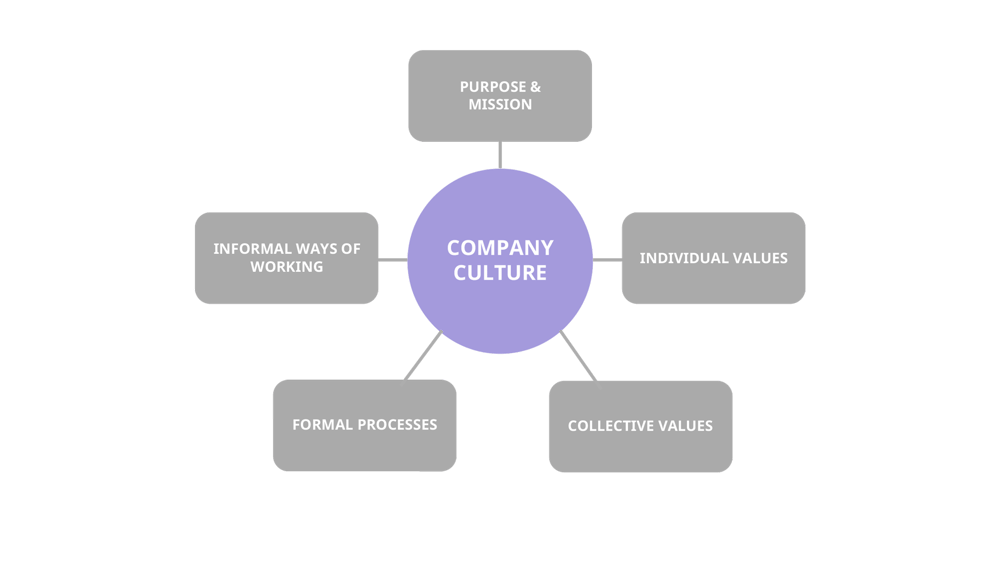Innovation Culture – The Ultimate Guide
Innovation culture has long been one of the most challenging, and oft-discussed, topics in our conversations with business and innovation leaders.
Given the extraordinary importance of innovation for businesses, and society in general, and the fact that culture has been shown to be one of the biggest barriers for innovation performance, it’s not much of a surprise.
Because most large companies we talk to want to create a more innovative company culture, we thought we’d create this extensive guide to help understand what really makes a culture innovative, as well as how to actually shape an existing culture towards innovation.
Table of contents

What is an innovation culture?
The question we need start with is to actually define what an innovation culture is.
And to answer that, we need to take a step back and take a look at what an organizational culture really is, since it’s often seen as such a fuzzy and abstract concept.
However, it’s actually quite a straightforward thing. According to an HBR article, culture is the consistent, observable patterns of behavior in an organization.
Or as Aristotle once said: “We are what we repeatedly do.”
Thus, an organizational culture is basically a sum of all the practices, processes, habits, values, structures, incentives, and naturally people, that the organization has. It’s really important for leaders to understand that culture isn’t just a warm and fuzzy feeling, or an end result of a well-worded value statement, but a very concrete representation of what actually happens in the organization, especially when someone isn’t there to give explicit instructions.
It’s really important for leaders to understand that culture isn’t just a warm and fuzzy feeling, or an end result of a well-worded value statement, but a very concrete representation of what actually happens in the organization, especially when someone isn’t there to give explicit instructions.
An innovation culture is an organizational culture that really values and supports innovation, so that people can actually make innovation happen.
Thus, an innovation culture is simply an organizational culture that really values and supports innovation, so that people can actually make innovation happen around the organization.
All innovative company cultures have plenty of things in common, but there are also individual differences between companies.
Why is an innovative culture so important?
Before we get there, however, let’s have a quick recap on the importance of having an innovative company culture.
Last year, we did a meta-analysis of all the available research on innovation performance. When we put the results together, the lack of cultural support for innovation came out on the shared top spot with a whopping 64% of the studies mentioning it as a key obstacle. Based on the research, combined with our own experience, I think there are two main reasons for this:
Based on the research, combined with our own experience, I think there are two main reasons for this:
1. Lack of effort
If the larger organization doesn’t value innovation, or worse, if innovation is actively discouraged, most people around the organization simply won’t see innovation as something that would be needed, or that they should be working towards.
And, in this kind of an environment, even the outliers that really want to innovate, quickly either get discouraged and leave the organization, or become unmotivated and lose their desire to innovate.
When put together, this creates a powerful barrier that prevents innovation from ever getting off the ground.
2. Lack of support
Even if an innovation does miraculously get off the ground in that kind of a culture, it will quickly run out of fuel when the person working on it needs to get dozens of people to sign off and approve of their idea to get permission to do anything. And even if that happens, nobody would really be rooting for your success, which doesn’t exactly help either.
When the previous ideas and innovation attempts haven’t really led to any meaningful results, other new ideas are unlikely to get funding or access to other resources.
When put together, these factors are an extremely powerful force for keeping things the same that they’ve always been.
Organizations with an innovative culture, on the other hand, are the exact opposite of this. People constantly talk about the importance of innovation and new ideas are encouraged. There are tools and processes in place to capture and progress them. And when these ideas pop up, people do their best to find ways to quickly try them out.
People constantly talk about the importance of innovation and new ideas are encouraged. There are tools and processes in place to capture and progress them. And when these ideas pop up, people do their best to find ways to quickly try them out.
All of that leads to the company obviously learning more, but also creating measurable positive impact, which again fuels the desire for more innovation.
Simply put, a strong innovation culture is the engine that drives the organization to constantly get better, move forward, and innovate.
A strong innovation culture is the engine that drives the organization to constantly get better, move forward, and innovate.
While there are many kinds of strong cultures that don’t focus on innovation, innovation cultures are always examples of strong organizational cultures.
The importance of a strong culture is especially apparent when the organization is facing a crisis or other kind of an extremely challenging situation, which unfortunately so many currently are.
Organizations that have a strong culture, generally gel together in the face of adversity and actually perform better in a crisis than in normal times. In these kinds of organizations, everyone really knows why the company exists, trusts the leadership, and believes in doing their own part to advance that because they know that the person next to them will also do the same. On the other hand, those with a weak culture tend to do worse. They often lose their will to fight or go into a “survival of the fittest” mode where every employee is only looking out for their own interests as opposed to those of the organization and their colleagues.
On the other hand, those with a weak culture tend to do worse. They often lose their will to fight or go into a “survival of the fittest” mode where every employee is only looking out for their own interests as opposed to those of the organization and their colleagues.
What makes a culture innovative?
Harvard Professor Gary Pisano recently wrote an excellent piece on The Hard Truth About Innovative Cultures, which I think perfectly captures the essence of why creating a truly innovative company culture is so difficult.
According to Pisano, innovative cultures are often very misunderstood. He goes on to say:
"The easy-to-like behaviors that get so much attention are only one side of the coin. They must be counterbalanced by some tougher and frankly less fun behaviors.
A tolerance for failure requires an intolerance for incompetence. A willingness to experiment requires rigorous discipline. Psychological safety requires comfort with brutal candor. Collaboration must be balanced with individual accountability. And flatness requires strong leadership. Innovative cultures are paradoxical.
Unless the tensions created by this paradox are carefully managed, attempts to create an innovative culture will fail.”
It is this paradoxical ability of being able to combine attributes and behaviors that are typically seen as mutually exclusive, that really creates an innovative culture.
So, to get real results from innovation, you need to have the right kind of balance across a range of key characteristics and behaviors. And yes, you do really need to include all of them in the mix. To help with the process of assessing your own innovation culture, we’ve created the above Scorecard, which is a part of our Innovation Culture Toolkit.
To help with the process of assessing your own innovation culture, we’ve created the above Scorecard, which is a part of our Innovation Culture Toolkit.
The basic idea is that if the dots on each row are not in balance, that specific characteristic is likely to become a bottleneck that’s holding your culture back.
And of course, the more dots you’ve colored on the scorecard overall, the better suited your culture basically is towards innovation, so you should ideally aim to increase your abilities across each of these characteristics.
As with anything else innovation related, it of course isn’t just that black and white. There really isn’t just a single “correct” mix or path, but the exact formula depends on what kind of innovation you’re pursuing.
For example, if you’re mostly focused on incremental innovation, perhaps you need to be a bit more disciplined, but don’t necessarily need as strong leadership. Whereas, if you really want to transform your organization with innovation big time, you’ll need extremely strong leadership, but also a bit more freedom for people to find ways to adapt to this new approach.
Examples of innovative company cultures
To try to get a better understanding of what innovative company cultures look like in practice, let’s take a look at a few examples that will hopefully help shed light on certain aspects of these cultures.
Pixar
Pixar, as everyone knows, is probably the most famous and successful company in a very creative industry, namely animated films.
They were a clear pioneer in their industry with a very strong collaborative and mission-driven culture, which Founder Ed Catmull describes in detail in his excellent book Creativity, Inc. It’s really a must read book for anyone interested in creating an innovative company culture.
Pixar managed to keep their culture intact despite rapid growth and actually managed to scale creativity without sacrificing quality, thanks in large part to a number of key principles and practices they had in place. We can’t unfortunately go into too much detail on the specifics here, but in general, Pixar does provide a lot of freedom and psychological safety for their teams, while still keeping the bar for performance extremely high.
We can’t unfortunately go into too much detail on the specifics here, but in general, Pixar does provide a lot of freedom and psychological safety for their teams, while still keeping the bar for performance extremely high.
Perhaps the most famous example of these practices is the Braintrust, a regular meeting where all the most experienced creative directors of the company meet to assess progress for each ongoing project. The primary aim of the meeting is to provide brutally candid feedback to, as Catmull phrases it, “push us toward excellence and to root out mediocrity”.
To imagine how intimidating and brutal this can be, how would you feel if you had every CXO and VP in your company provide you with completely unfiltered feedback and point out every potential flaw in every incomplete project you’re working on, at a regular interval?
However, once you know that the meeting is there to help everyone, and you see all of the aforementioned executives struggle with their own projects in turn, you’ll quickly build trust and gel together as a team. This naturally helps in achieving a much higher level of quality than you otherwise would have been able to.
While this method obviously isn’t directly applicable to every business, it highlights how important the more unpleasant sides of innovative cultures actually are for building a strong culture designed to achieve excellence.
In general, all the principles used at Pixar are very much in line with the characteristics we outlined above. As a matter of fact, if we were to rate Pixar with that scorecard, they’d get nearly full scores pretty much across the board.
Tesla
Tesla is another great example of a company that keeps innovating and pushing the boundaries, and they too have a very strong innovation-oriented culture.
Many employees consider the company to be a demanding, yet extremely rewarding place to work with brilliant colleagues and a great culture.
However, there seem to be nearly as many who really dislike the company because it is a very demanding place where going above and beyond your job is often expected from virtually everyone. That is something that many people, especially in the front lines of the company, seem to find quite unattractive. That goes to show that truly innovative company cultures aren’t a perfect utopia where everything is great. They obviously have their pros, but they also have their cons, and certainly aren’t the right fit for everyone.
That goes to show that truly innovative company cultures aren’t a perfect utopia where everything is great. They obviously have their pros, but they also have their cons, and certainly aren’t the right fit for everyone.
Microsoft
Microsoft, as everyone knows, is an example of a pioneering company that once led us to the PC age and grew to 140 000 employees all around the globe, became stagnant, and fell into a bit of a slump of mediocrity.
Their culture had become individualistic and bureaucratic, and collaboration had apparently given way to internal competition, and a fear of failure.
As Chief People Officer Kathleen Hogan shares, once Satya Nadella became the CEO, they embarked on a journey to transform the culture towards a more innovative, empathetic and purpose-driven culture with a focus on a humility and growth mindset.
While the change took time, and to some extent, is still underway, the results have been dramatic and clearly show in their financial results, but also in a variety of other factors, such as employee satisfaction, and brand image.
As Hogan points out, while the transformation has to start from the top, it has to be reinforced with communication and practices at every level of the organization, and in everything it does, to really have a chance of succeeding.
Without that kind of a commitment, such a dramatic change in the culture of such a huge organization simply wouldn’t be possible.
How to create a more innovative culture
As with everything culture related, it’s always easier to start from a clean slate and shape the right kind of culture from the get-go, than it is to transform an existing culture.
However, medium and large organizations obviously don’t really have that luxury since they always have some kind of an existing culture in place, just like there was at Microsoft.
Thus, if you need to transform your existing, perhaps a bit stagnant, culture towards a new trajectory of growth and innovation, you’re going to need to take decisive action, and understand that it will take quite a bit of time and effort to get things to change. Based on our experience, there are a few key things you should be focusing on to have the best possible chance of achieving such a transformation. These are, for the most part, applicable to any kind of a cultural transformations and not just for innovation cultures.
1. Understand the status quo – and why it is like it is
Unfortunately, cultural change programs can often be nothing more than a few new values that a newly elected leadership of a company would like to see more of, without truly understanding the existing dynamics within the organization.
Every culture has strengths that have made the company into what it is, but also their challenges that are holding it back.
It’s also really important to understand why things are the way they are. Is the company mostly a result of the people that have been hired? Has it perhaps been shaped by the choices made in rewarding and promoting employees, or by the structure and processes the organization has?
By truly understanding the mechanics of your cultural system, you can preserve and cherish the strengths, but also introduce changes to things that can actually make a difference.
This is very much what Hogan and her colleagues at Microsoft also did at the beginning of their transformational journey.
2. Cultural change starts from the top
A full-blown cultural transformation is such a massive undertaking that it always has to start from the top. It requires strong leadership and extensive commitment from top management.
Leaders really do need to become role models for the kind of behavior that is expected from everyone, but that isn’t enough.
Leaders must constantly communicate the destination and the importance of this transformation in virtually all of their messaging, and be prepared to “walk the walk”, by committing to make the practical changes required to enforce the change.
3. …but truly happens from the bottom-up
As mentioned, while the transformation has to start from the top, it doesn’t happen if employees throughout the organization don’t buy-in, or if the ways of working within the company don’t also change at the grassroots level.
Remember, culture is simply a representation of the way people act in their day-to-day, and if that doesn’t change, nothing will happen regardless of how often you talk about the new culture.
Thus, you have to make forceful and impactful changes in everything that guides people’s behavior on a day-to-day basis. In practice, that means at least:
- Communication and management practices
- Resource allocation processes
- Hiring and firing decisions
- Rewards and promotions
For example, if you say that you value teamwork, but keep promoting people who aren’t afraid to throw their colleagues “under the bus” to make themselves look better, it’s quite clear that that’s the kind of behavior people will then adopt and emulate. A while back, I heard of quite a small company where management said that they are a very flat organization and that really values the expertise of every employee highly. Yet, they rarely bothered to ask the employees for input and made every decision exclusively in their management meetings, and even forbade employees from using the nicer coffee cups that were reserved for the management and guests from key accounts.
A while back, I heard of quite a small company where management said that they are a very flat organization and that really values the expertise of every employee highly. Yet, they rarely bothered to ask the employees for input and made every decision exclusively in their management meetings, and even forbade employees from using the nicer coffee cups that were reserved for the management and guests from key accounts.
While these practices probably aren’t ideal, the real problem was that they were clearly very different from what management communicated, which meant that the management quickly lost their credibility with employees because of these double standards.
The devil really is in the details when it comes to cultural change.
The devil really is in the details when it comes to cultural change.
Here are a few practical suggestions that might help in creating a more innovation-oriented culture:
- Start with an idea challenge asking every employee what’s preventing them from innovating or from otherwise making progress, and commit to fixing many of these
- Run an idea challenge asking every employee to pinpoint the biggest frustrations existing customers have, and reserve budget for addressing some of them
- Introduce continuous improvement processes for doing incremental innovation across the organization
- Reward and celebrate employees who contribute towards new innovations in addition to their own role
- Give anyone in the organization the possibility to test their ideas by applying for a toolkit like the Adobe Kickbox
- Consider innovativeness and desire to make real change happen in every hiring decision across the organization
4. Clear focus – and quick wins to gain momentum
In a large organization, you can’t possible change everything overnight. Thus, it’s really important that you don’t even try to do that.
Just choose a few of the most important areas that can really make a difference and start from those. Make sure that you can score some “quick wins” with the first initiatives, as this will help get everyone onboard and excited about the upcoming journey.
Then once you get things done, systematically keep making your way down the list you just created.
5. Communicate, communicate, communicate – and with purpose
As most of us in leadership positions have learned, you really need to keep communicating the same things over, and over, and over to get the message through.
And when you think you really can’t take it anymore, you’re likely just starting to get through to most of the employees. The same principle applies for cultural change too. The message needs to be repeated, and it needs to be consistent across all levels of the organization.
The same principle applies for cultural change too. The message needs to be repeated, and it needs to be consistent across all levels of the organization.
However, there are a couple of other tips that can really help to get the message through, and to get everyone onboard:
- Be transparent. When you’re honest and transparent about where you currently are, and where you want to go, you’ll get people’s attention and build trust.
- Have a real purpose, or “the why”. If the transformation doesn’t really have a big and meaningful purpose behind it, it’s unlikely that you’ll get the majority onboard. On the other hand, if that “why” is either a question of life and death for the organization, or a highly aspirational goal like an authentic way to make the world a better place, you’ll be guaranteed to win people over.
- Create a motto. Good mottos are really memorable and great at capturing people’s imagination because they’re so concise and to the point. For example, pretty much everyone in the business world knows Facebook’s culture as being symbolized by their old motto: “Move fast and break things”. It’s a great motto because it communicates a very conscious decision about what the company values, and what it is willing to sacrifice to make that happen. Later on, they changed it to “Move fast with stable infrastructure”, which although not as catchy, was still effective in communicating the changing priorities of the company as it grew.
- Use stories. The final tip is to use stories to reinforce your message and make it more memorable. People rarely remember stats, or a list of values, but they always remember great stories. If it’s an emotional and personal one, you’re guaranteed to make an impact with it.
6. Measure, learn, and iterate
And finally, as culture doesn’t change overnight, you have to be prepared for an extended period of ongoing adjustments. Whenever one embarks on a cultural transformation, the only thing that is certain is that everything won’t go as planned.
Whenever one embarks on a cultural transformation, the only thing that is certain is that everything won’t go as planned.
A common mistake many make is to simply execute on the initial transformation plan, and then look for positive signals that show that you’re heading in the right direction.
In reality, it should be other way around. You need to look for objective data and signals that show where you’re not making progress, then learn why that is the case, and find ways to adjust your plan so as to address those isolated pockets where there is resistance to change.
You can use the scorecard we introduced above to help make this process more systematic.
Cultural change is always an iterative process, so be prepared for the challenges that you’ll inevitably face, and you’ll surely find ways to overcome them with perseverance.
Conclusion
Having a culture of innovation is vital for any organization that is looking to innovate and achieve or maintain a leading position in their own field.
It’s the foundation that really enables organizations to innovate repeatably, and at scale. Many leaders also sorely underestimate the importance this has on not just financial results, but also on the impact an organization can make at large.
There are, however, a lot of misconceptions about innovative organizational cultures. It isn’t just the warm and fuzzy startup vibe we’re often led to believe it is. These cultures certainly aren’t all fun and games.
Sure, an innovation culture always has room for creativity, empathy, and freedom, but those attributes also need to be balanced with some of the tougher, and frankly not so fun, ones like discipline and individual accountability.
Having said that, creating an innovation culture isn’t impossible, it just takes a lot of dedication, persistence and hard work. If you’d like to assess the current status of your innovation culture, or would like to transform it towards being more innovative, you can download a copy of our Innovation Culture Toolkit to help with process.
If you’d like to assess the current status of your innovation culture, or would like to transform it towards being more innovative, you can download a copy of our Innovation Culture Toolkit to help with process.





